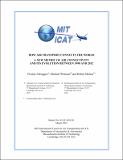How Air Transport Connects The World: A New Metric of Air Connectivity and Its Evolution Between 1990 And 2012
Author(s)
Allroggen, Florian; Wittman, Michael; Malina, Robert
DownloadICAT-2015-01-Malina-Wittman-Allroggen.pdf (4.078Mb)
Metadata
Show full item recordAbstract
Scheduled air transport services connect airports throughout the world and thereby enable interaction on a global scale. By doing so, they spur globalization (Hummels, 2007) as well as social and economic development (Lakshmanan, 2011). In order to facilitate integration of regions into global value chains, planners, scholars and policymakers therefore need to
understand as to how scheduled air transport services link a region to other markets. For this purpose, connectivity metrics have been developed, which measure the degree of connections between airports (Burghouwt, Redondi, 2013). In particular, the ‘connection quality-weighting’ approach (Veldhuis, 1997; Burghouwt, de Wit, 2005) has been used to compute the aggregate
quality of all available connections at an airport with regard to their properties in quickly bridging distances. However, such a metric has neither been calibrated on the basis of observed passenger behavior nor been computed for the world’s airports across a multi-decade time series. This paper sets out to develop the first such metric and to discuss global airline network
development between 1990 and 2012 from a connectivity perspective.
Date issued
2015-03-11Series/Report no.
ICAT;2015-01
Keywords
Air Transportation, global value chains, global connectivity